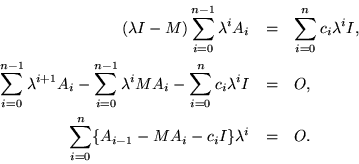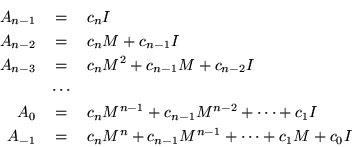Continuing on, it turns out that the resolvent can be calculated, in terms of the coefficients of the characteristic polynomial. Needing the adjugate of
![]() , we start by knowing that it is a polynomial of degree
, we start by knowing that it is a polynomial of degree ![]() in
in ![]() because that is the maximum dimension of the cofactors and thus the maximum number of
because that is the maximum dimension of the cofactors and thus the maximum number of ![]() s which could ever be multiplied together. Grouping the coefficients of
s which could ever be multiplied together. Grouping the coefficients of ![]() together in a matrix called
together in a matrix called ![]() , set
, set




![\begin{eqnarray*}
\left[ \begin{array}{c}
O \\ A_0 \\ \ldots \\ A_{n-3} \\ A_...
...\ M \\ \ldots \\ M^{n-2} \\ M^{n-1} \\ M^n \end{array} \right].
\end{eqnarray*}](img140.gif)
Matrices of the strip antidiagonal form evident in this equation are called Hankel matricesHankel matrix; they occur frequently in such contexts as the moment problem or in fitting least squares approximations.